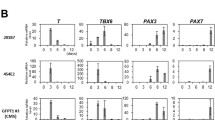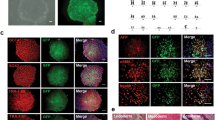Abstract
Most muscular dystrophies are the result of genetic disorders. There is currently no effective treatment for these progressive diseases except palliative therapy. Muscle stem cells with potent self-renewal and regenerative potential are considered a target for treating muscular dystrophy. Human induced pluripotent stem cells have been expected as a source of MuSCs because of their infinite proliferation potential and less immunogenicity. However, the generation of engraftable MuSCs from hiPSCs is relatively difficult and encounters low efficiency and reproducibility. Here, we introduce a transgene-free protocol of hiPSCs differentiating into fetal MuSCs by identifying them as MYF5-positive cells. Flow cytometry analysis detected around 10% of MYF5-positive cells after 12 weeks of differentiation. Approximately 50 ~ 60% of MYF5-positive cells were positively identified using Pax7 immunostaining. This differentiation protocol is expected to be useful for not only the establishment of cell therapy but also the future drug discovery using patient-derived hiPSCs.
Access this chapter
Tax calculation will be finalised at checkout
Purchases are for personal use only
Similar content being viewed by others
References
Hoffman EP, Brown RH Jr, Kunkel LM (1987) Dystrophin: the protein product of the Duchenne muscular dystrophy locus. Cell 51:919–928. https://doi.org/10.1016/0092-8674(87)90579-4
Fairclough RJ, Wood MJ, Davies KE (2013) Therapy for Duchenne muscular dystrophy: renewed optimism from genetic approaches. Nat Rev Genet 14:373–378. https://doi.org/10.1038/nrg3460
Takahashi K, Tanabe K, Ohnuki M et al (2007) Induction of pluripotent stem cells from adult human fibroblasts by defined factors. Cell 131:861–872
Darabi R, Arpke RW, Irion S et al (2012) Human ES- and iPS-derived myogenic progenitors restore DYSTROPHIN and improve contractility upon transplantation in dystrophic mice. Cell Stem Cell 10:610–619. https://doi.org/10.1016/j.stem.2012.02.015
Tedesco FS, Gerli MFM, Perani L et al (2012) Transplantation of genetically corrected human iPSC-derived progenitors in mice with limb-girdle muscular dystrophy. Sci Transl Med 4:140ra189. https://doi.org/10.1126/scitranslmed.3003541
Shelton M, Metz J, Jun L et al (2014) Derivation and expansion of PAX7-positive muscle progenitors from human and mouse embryonic stem cells. Stem Cell Rep 3:516–529. https://doi.org/10.1016/j.stemcr.2014.07.001
Chal J, Oginuma M, Al Tanoury Z et al (2015) Differentiation of pluripotent stem cells to muscle fiber to model Duchenne muscular dystrophy. Nat Biotechnol 33:962–969. https://doi.org/10.1038/nbt.3297
Kim J, Magli A, Chan SSK et al (2017) Expansion and purification are critical for the therapeutic application of pluripotent stem cell-derived myogenic progenitors. Stem Cell Rep 9:12–22. https://doi.org/10.1016/j.stemcr.2017.04.022
Tierney MT, Gromova A, Sesillo FB et al (2016) Autonomous extracellular matrix remodeling controls a progressive adaptation in muscle stem cell regenerative capacity during development. Cell Rep 14:1940–1952. https://doi.org/10.1016/j.celrep.2016.01.072
Zhao M, Tazumi A, Takatyama S et al (2020) Induced fetal human muscle stem cells with high therapeutic potential in a mouse muscular dystrophy model. Stem Cell Rep 15:80–94. https://doi.org/10.1016/j.stemcr.2020.06.004
Nakagawa M, Taniguchi Y, Senda S et al (2014) A novel efficient feeder-free culture system for the derivation of human induced pluripotent stem cells. Sci Rep 4:3594. https://doi.org/10.1038/srep03594
Hicks MR, Hiserodt J, Paras K et al (2018) ERBB3 and NGFR mark a distinct skeletal muscle progenitor cell in human development and hPSCs. Nat Cell Biol 20:46–57. https://doi.org/10.1038/s41556-017-0010-2
Uezumi A, Nakatani M, Ikemoto-Uezumi M et al (2016) Cell-surface protein profiling identifies distinctive markers of progenitor cells in human skeletal muscle. Stem Cell Rep 7:263–278. https://doi.org/10.1016/j.stemcr.2016.07.004
Sakurai H, Inami Y, Tamamura Y et al (2009) Bidirectional induction toward paraxial mesodermal derivatives from mouse ES cells in chemically defined medium. Stem Cell Res 3:157–169. https://doi.org/10.1016/j.scr.2009.08.002
Author information
Authors and Affiliations
Corresponding author
Editor information
Editors and Affiliations
Rights and permissions
Copyright information
© 2023 Springer Science+Business Media, LLC, part of Springer Nature
About this protocol
Cite this protocol
Sato, M., Zhao, M., Sakurai, H. (2023). Differentiation of Human Fetal Muscle Stem Cells from Induced Pluripotent Stem Cells. In: Asakura, A. (eds) Skeletal Muscle Stem Cells. Methods in Molecular Biology, vol 2640. Humana, New York, NY. https://doi.org/10.1007/978-1-0716-3036-5_11
Download citation
DOI: https://doi.org/10.1007/978-1-0716-3036-5_11
Published:
Publisher Name: Humana, New York, NY
Print ISBN: 978-1-0716-3035-8
Online ISBN: 978-1-0716-3036-5
eBook Packages: Springer Protocols




